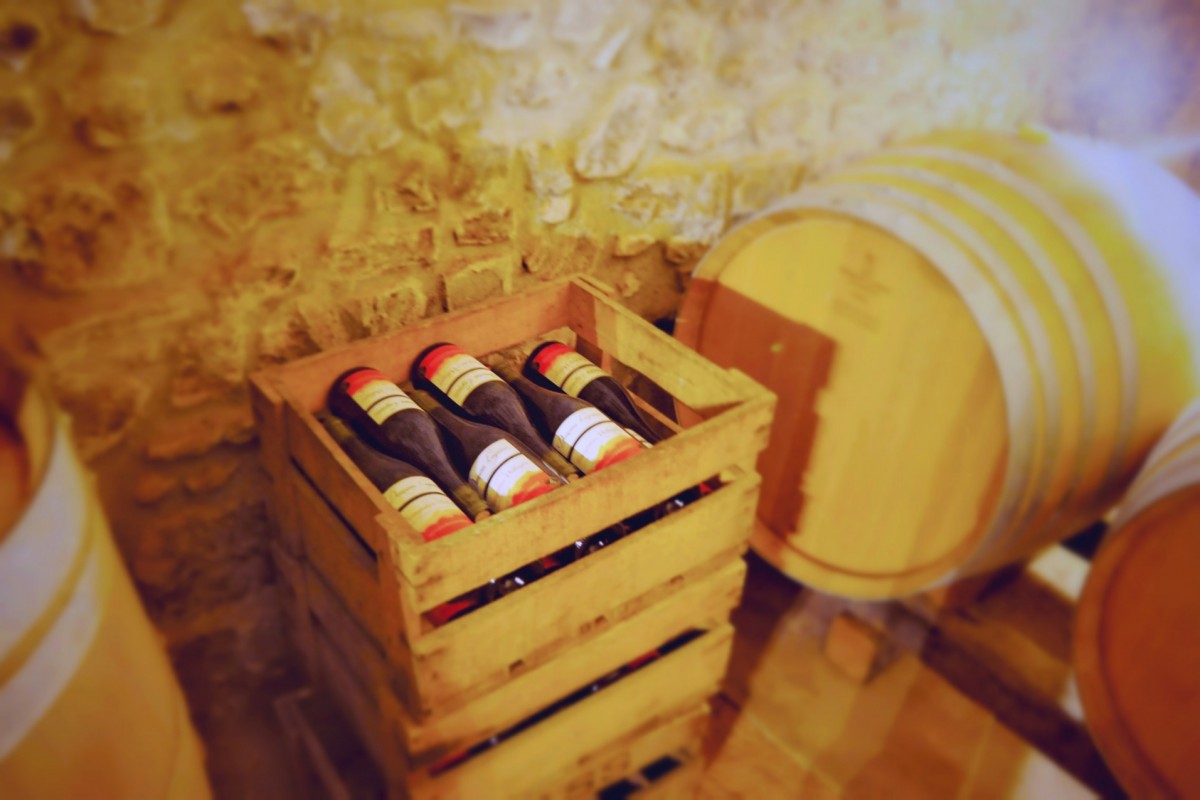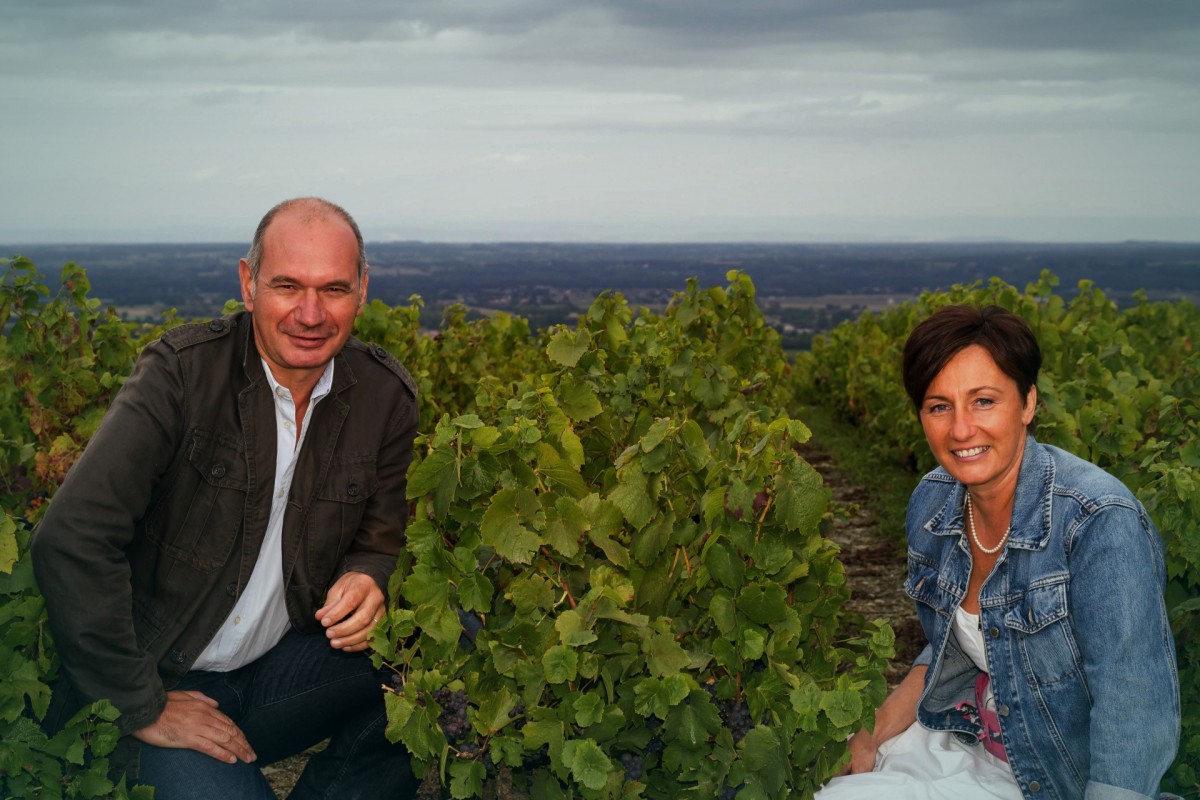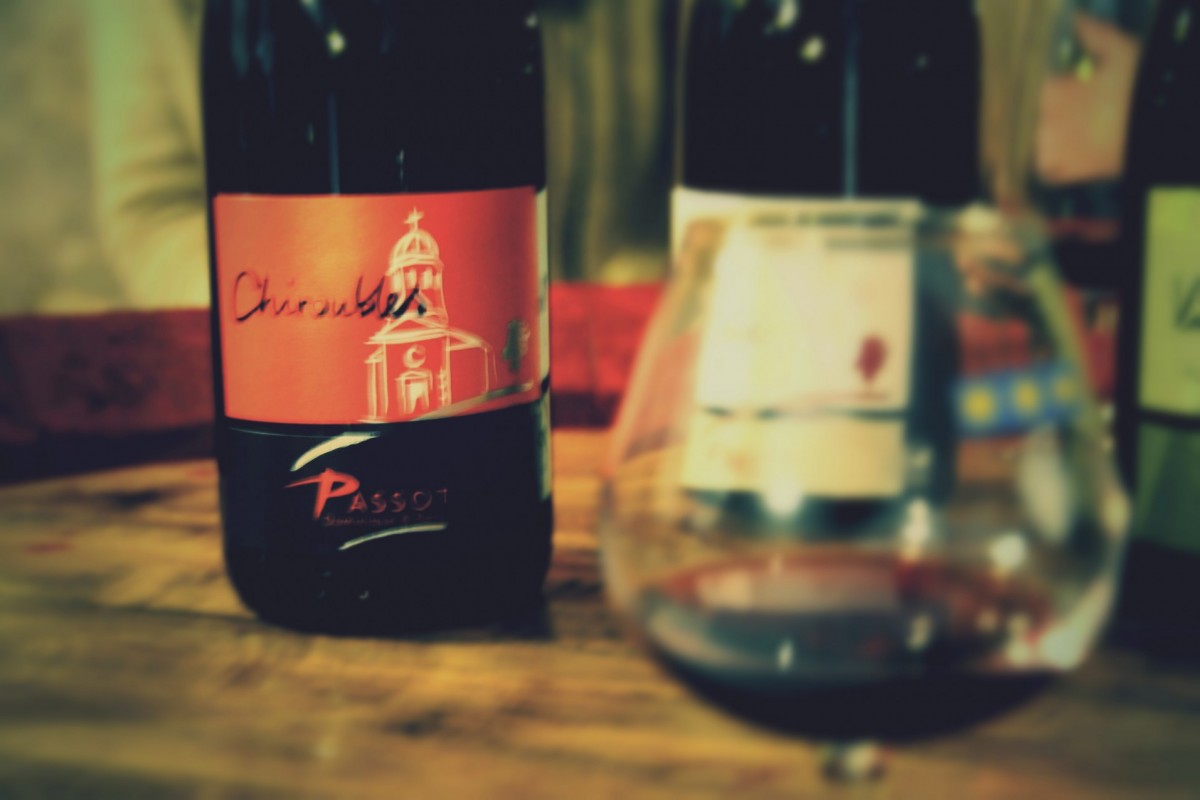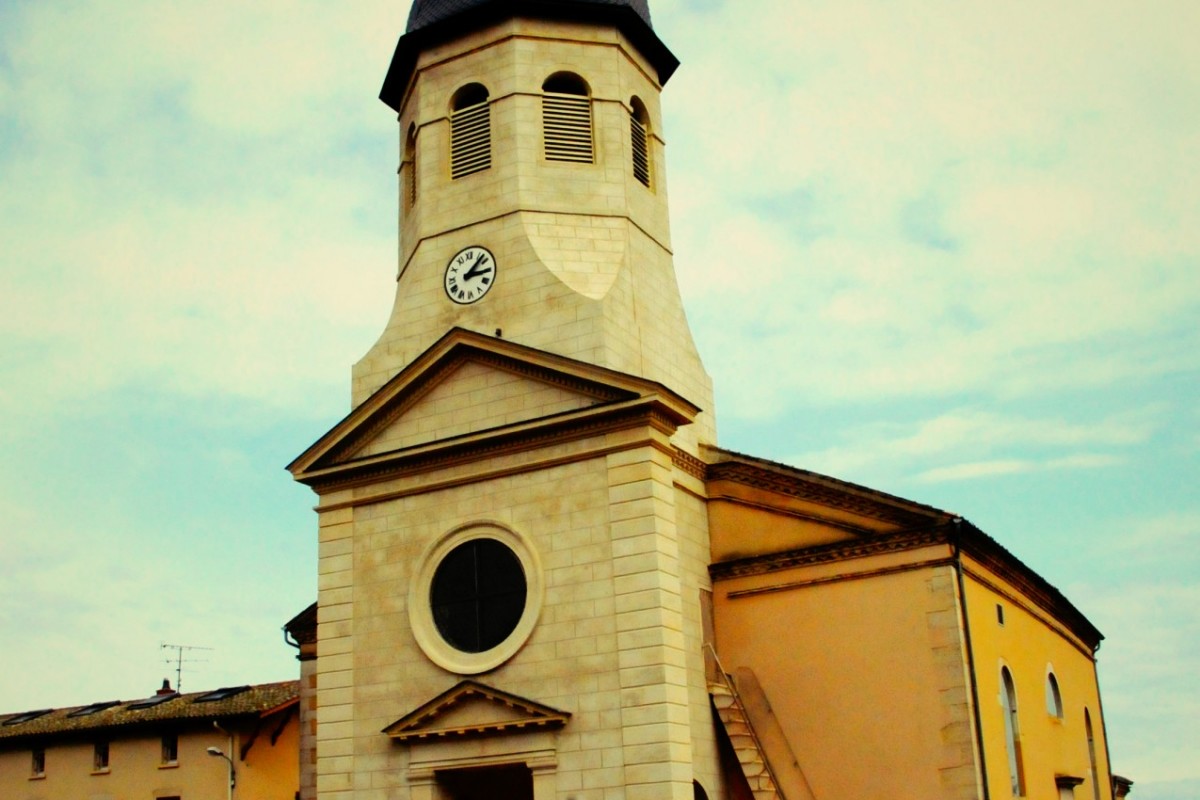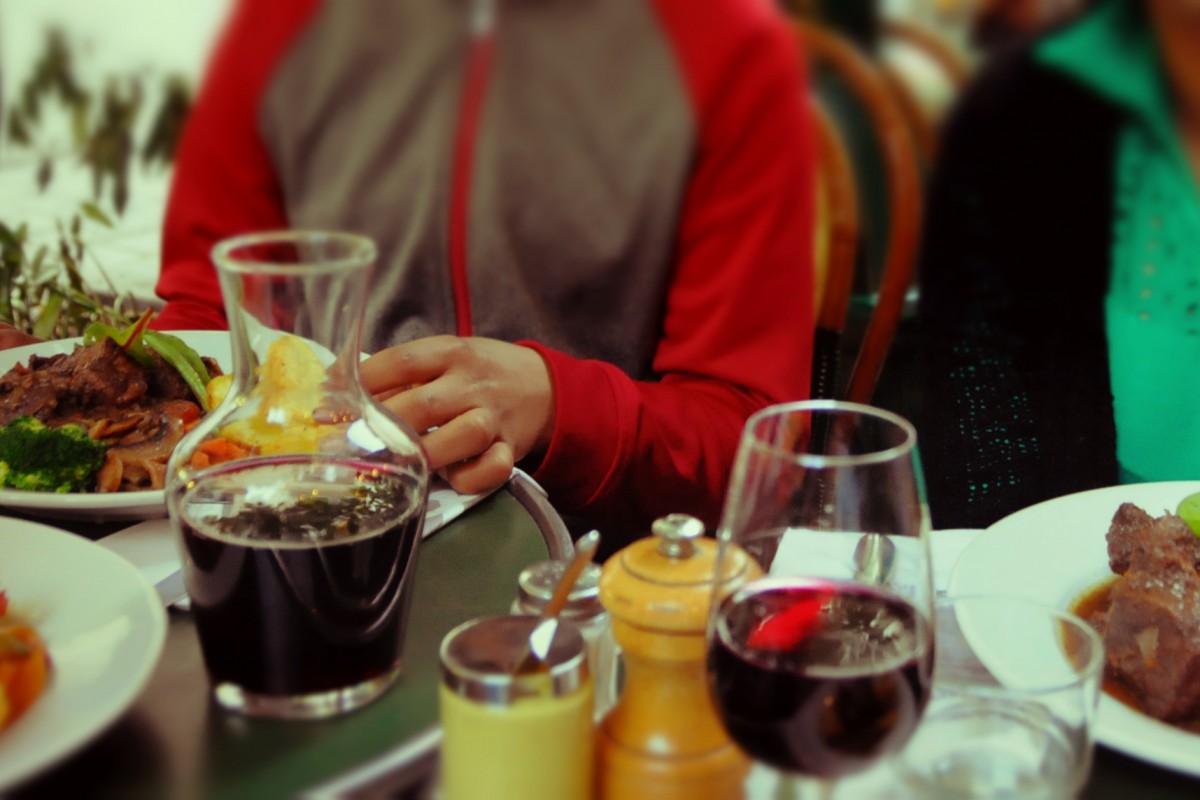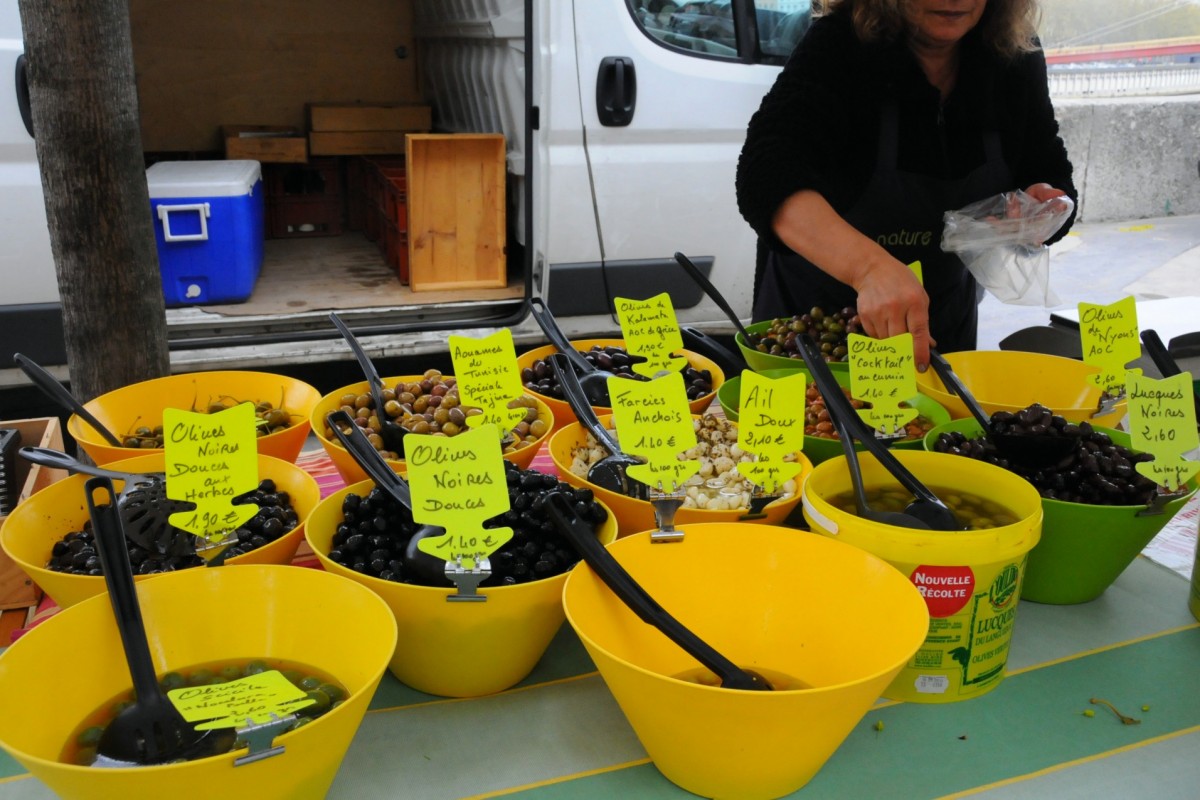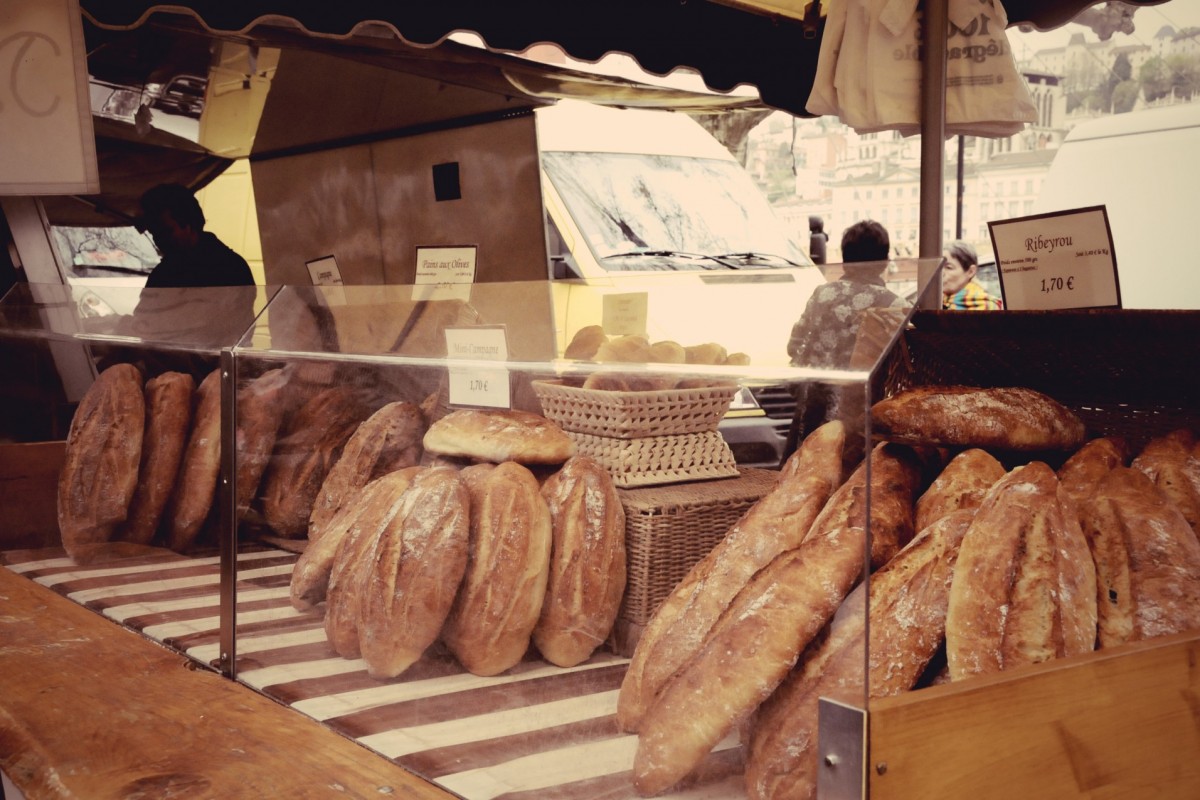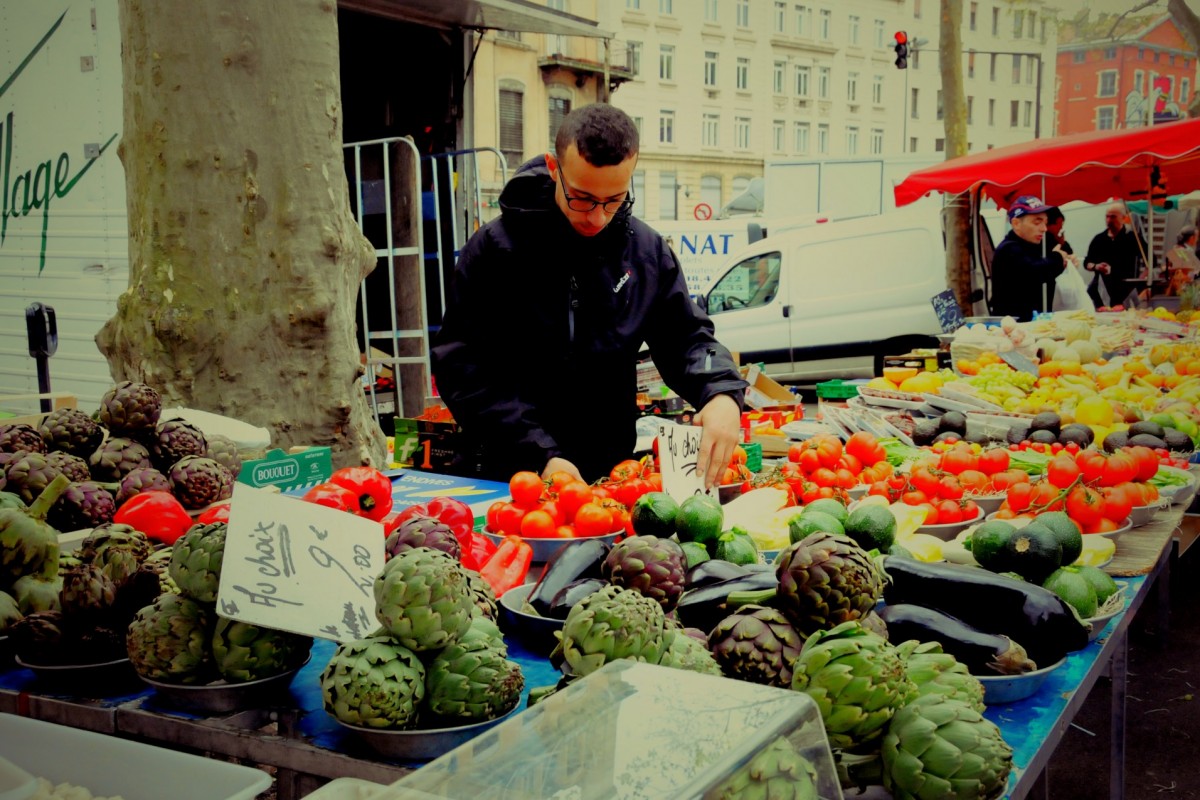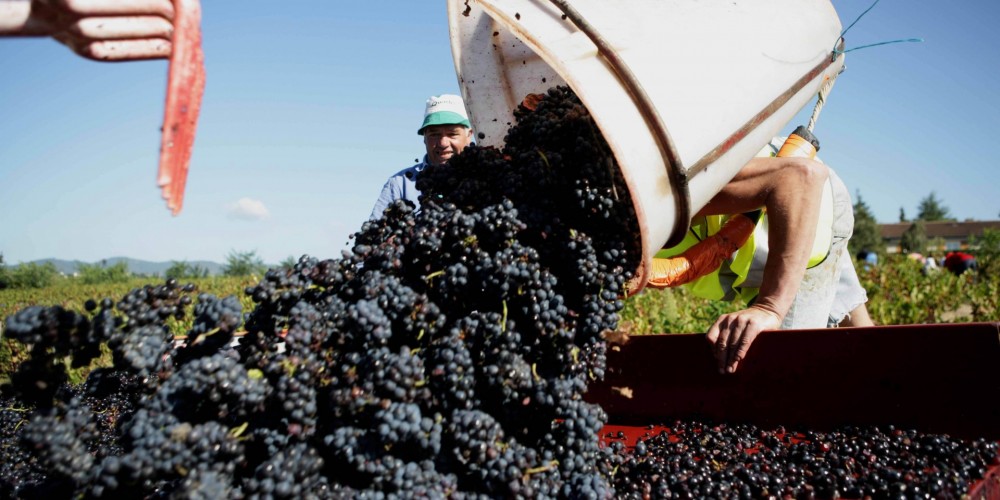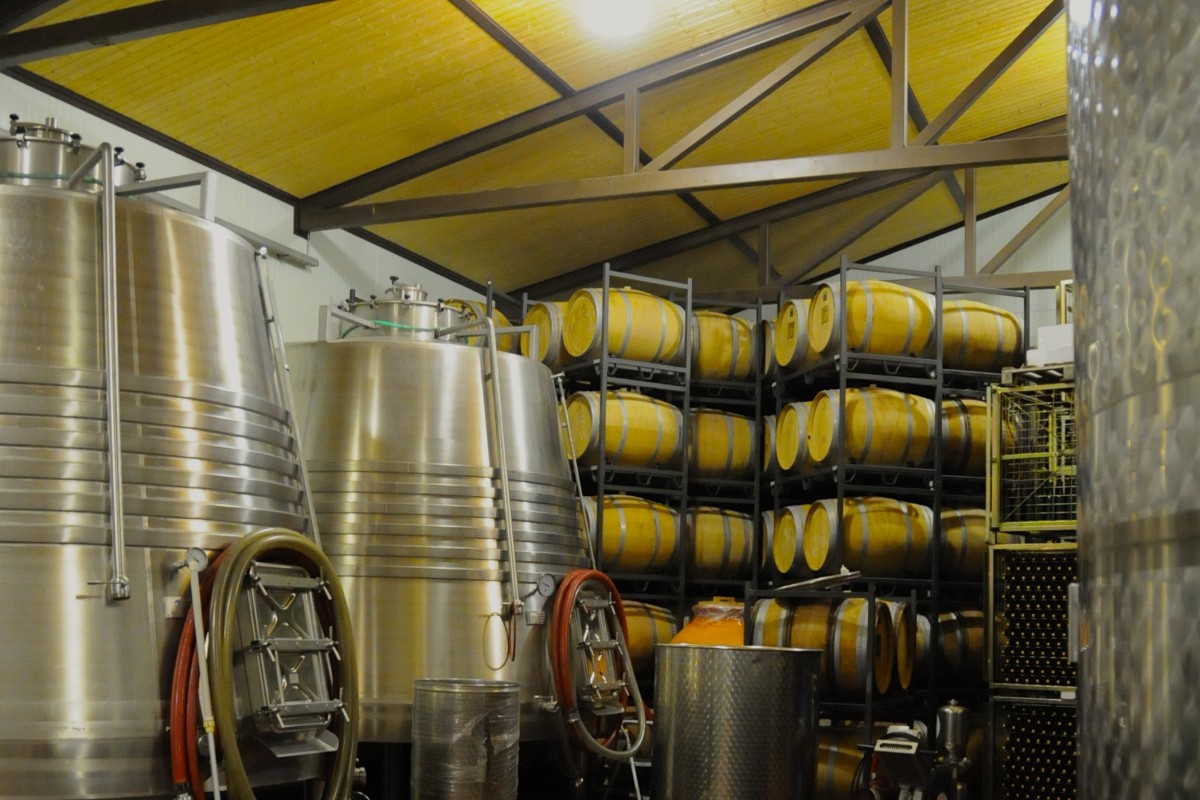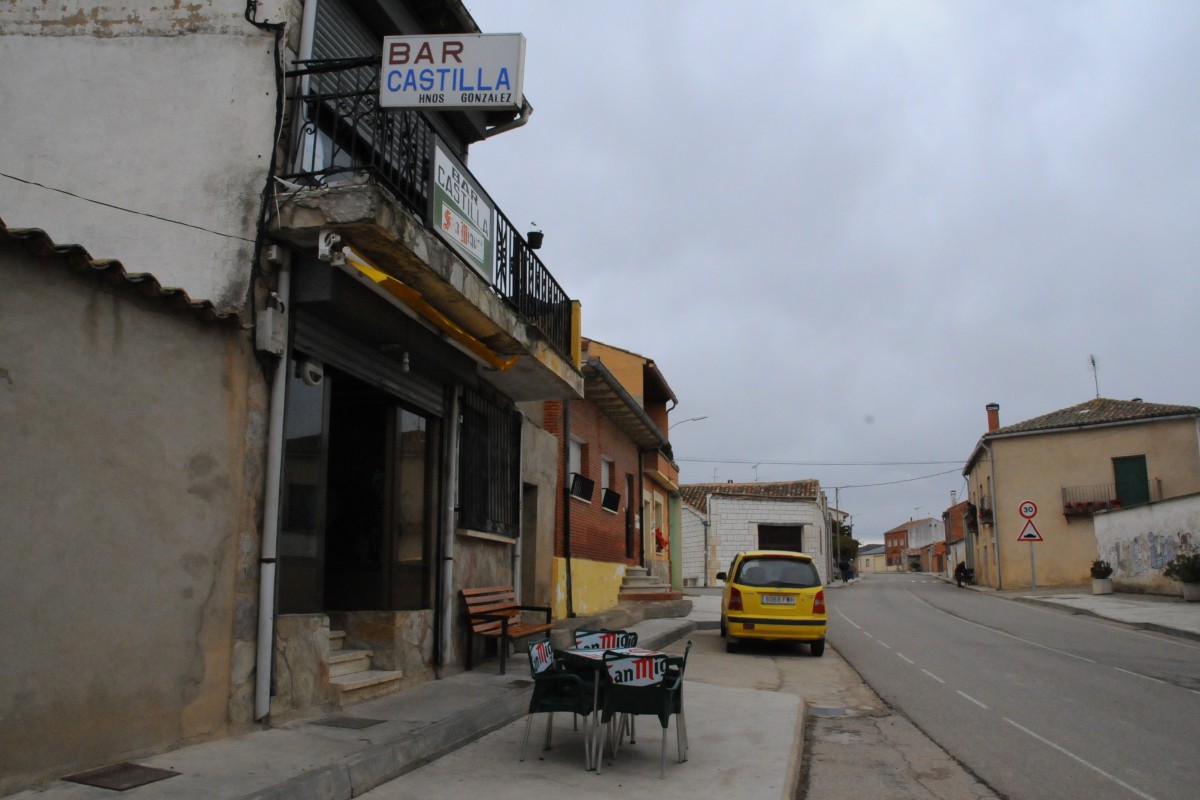10 Things about Beaujolais you wanted to know but were afraid to ask!

Why is this dog smiling? Juliénas..thats why!

When you arrive at home of Lilian and Sandrine, the odds are good you will be greeted by Fig. Fig is a yellow lab and he is still a puppy. For a puppy, he does a lot around the place. On our first visit, he kept our children occupied with his boundless energy and his constant demand for belly rubs. Fig loves belly rubs. Besides occupying underage visitors, he also keeps a keen eye on the vineyard when harvest is in session. Fig is the dog of the Matray family. Fig lives in Juliénas.

Where is Juliénas you ask? It is in Beaujolais. It is way north. In fact except for Saint Amour, it is the northernmost of the Cru areas (Cru refers to superior growing areas )
The Romans were in these parts quite a bit. The quaint town of Juliénas most likely gained it’s name from Julius Cesar (the one William Shakespeare wrote about, Et tu Brutus etc..). At least that is one version. Again depending on who you ask, Juliénas was probably one of the first vineyards planted by the Romans when they first conquered Gaul. So, wine in these parts goes way back. The wine from here is also called “Juliénas”. Not confusing at all! The soil here is mostly clay with some granite on the western edge. Like many parts of Beaujolais, Juliénas is further divided into smaller communities.
Some areas are better than others and make wines that are powerful and longliving. Some of these communities are : La Bottiére, Les Chers, Les Paquelets and Les Capitans. So, if you see a Juliénas that mentions any of the above the communes, you know it has some serious provenance. Our’s is from Les Paquelets.
Now, about the wine itself.
This is like all Beaujolais Cru, 100% Gamay Noir. These are powerful wines and benefit from long cellaring. Typically they are earthy wines, deep red in color and has aromas of strawberries, cinnamon, peonies and violets. Juliénas has an edge of spice to it.
 Our Juliénas comes from Les Paquelets from Domaine Matray. Lilian and his wife Sandrine are deeply passionate about their land. They should be rightfully so, as they make one of the most talked about Juliénas. In The Cheesemonger’s Tales: Of People and Places, Cheeses and Wines, Arthur Cunynghame says about the Matray vines,“With a south, south-east aspect, Lilian Matray’s vines are perfectly placed to ripen beautifully.” He also quotes Lilian about his approach to winemaking,
Our Juliénas comes from Les Paquelets from Domaine Matray. Lilian and his wife Sandrine are deeply passionate about their land. They should be rightfully so, as they make one of the most talked about Juliénas. In The Cheesemonger’s Tales: Of People and Places, Cheeses and Wines, Arthur Cunynghame says about the Matray vines,“With a south, south-east aspect, Lilian Matray’s vines are perfectly placed to ripen beautifully.” He also quotes Lilian about his approach to winemaking,
“Wine is first and foremost a ‘terroir’. It is also a profession and, above all, a passion. Sandrine and I look after all the work in the vines from pruning to harvest, which remains manual. Following on this is the winemaking itself, right upto sales. Each stage is inseparable and receives as much care and thought as the last”.
Domaine Matray makes 2 cuvées of their Juliénas. The basic bottling Les Paquelets is unoaked while the Vielles Vignes from older vines is very mildly oaked. We couldn’t make up our mind which one we liked. So, we got both!

Now their Saint Amour is no slacker and has also gained a lot of press. The 2011 vintage was chosen as one of the season’s best wines by The Independent newspaper. They called it ” As gorgeous as a misty autumn morning….” They don’t make many bottles of this lovely wine. Many of you who bought this asked me if more bottles of this vintage are coming this year. Unfortunately, the answer is no. If you miss out on this, the next vintage (2014) will not be available until 2015!
If you live in Reno, NV, the Vielles Vignes and the Saint Amour are available at :
- Whispering Vine
- West Street Wine Bar.
If you live in California or anywhere else and would like to see any of these wines at your local wine stores, or have any questions about our wines, please contact us directly
We Own Here = Vee ohn eeyer = Vi on ear = Viognier. Thats right.. Viognier
Repeat after me: Vee-ohn-eeayay
I like Chardonnay. A really good Chardonnay. I mean a really, really good Chardonnay. And we have some amazing Chardonnay in the works for you guys- from Burgundy, Spain etc. But in the interest of discovering new wines, I would say there are some tasty alternatives to Chardonnay out there. We have the Rolle from Chateau des Sarrins which some of you tried and raved about. But today, I want to focus on the other white in our current portfolio, the Viognier from Remy Passot.
Viognier was pretty unknown in our parts until the last few years when it really starting making the rounds in the socialite circles. It became the Chardonnay alternative. If you were tired of drinking the fat, syrupy (cheap?) Chardonnays in the market, Viognier became the alternative. By the way, it is pronounced “Vee-ohn-eeyay”. Viognier is also grown in California. Tablas Creek in Paso Robles makes some good juice. So does our friends Jonathan and Susan Lachs of Cedarville in the Sierra Foothills. You should try them. But this grape has been around for a long time and is in fact one of the predominant white grape of the Rhone valley in France. It is in Northern Rhone near the town of Condrieu that Viognier achieves great heights. The appellation of Condrieu is a thin sliver of land that hugs the Rhone river for a few miles. Needless to say there isn’t much to go around. So, the economics of supply and demand makes this a pretty pricey wine. There are some excellent Viogniers from these parts, notably Georges Vernay and Chateau Grillet. That does not mean Condrieu is the only place where Viognier thrives.
Smart and resourceful vignerons figured out that Viognier grows quite well in the areas surrounding Condrieu extending down into the Rhone, a little east into the Jura and also a little north into Beaujolais country! These areas were given special designations and are now called IGP (Indication Géographique Protégée) Comtes Rhodaniens.
Say that 10 times – Indication Géographique Protégée Comtes Rhodaniens, Indication Géographique Protégée Comtes Rhodaniens, Indication Géographique Protégée Comtes Rhodaniens..eh never mind..!!
Remy Passot is a brilliant winegrower and it didn’t take him long to find a property in this IGP. Viognier happens to be Remy’s wife Dominique’s favorite white wine. This is a pretty young vineyard and the wines are joyful and delicious. Like young Viognier, there is peach, mangoes and other tropical aromas in this wine. They are meant to be drunk young maybe within 3 years of vintage. He doesn’t make a lot of it and so I grabbed all I could lay my hands on. So should you.

Do you have a favorite Thai or an Indian restaurant? Rent a copy of Kung Fu Hustle. Get a takeout of a Panang curry or grilled Tandoori chicken and wash it down with Dominique and Remy Passot’s delicious Viognier. Can you think of a better evening?
Find this wine and other wines from Dominique and Remy Passot at your local fine wine store or here.
BACKSTREET BOJO – 2

All Beaujolais are not the same. There are different tiers of quality of Beaujolais.
Starting with:
Beaujolais Nouveau: Harvested in September, released in November, this is juice that is barely fermented. Purple in color as young wines tend to be, this is as simple as it gets. What started as a local custom to announce the arrival of the wine (Le Beaujolais Nouveau est arrivé ; The Beaujolais Nouveau has arrived) has over the last few years gone on to be an international event every November. Brightly labelled bottles flood stores in Fall. These are very light wines, quite fruity, and some have a characteristic bubble-gum flavor! A lot of wine drinkers look down upon the Beaujolais Nouveau as it is not a serious wine and does not improve with age. I have had some really tasty Nouveau wine, but seriously you can get better Beaujolais for the same price. Try a Beaujolais Nouveau to get an idea, but lets look at better examples of Gamay
AOC Beaujolais: This is the basic wine of this area. Easy drinking. Fun. Fruity. Youthful. Some of the best Beaujolais come from the southern part of Beaujolais where the stones are golden in color and are referred to as pierres dorées or golden stones! I have posted an image below of the town of Liérgues as an example of these golden stones. Remember the wine at the Parisian bistro? More likely it was Beaujolais that was served. Although meant to be drunk young, some better Beaujolais can last for a good 2 years or so.
Beaujolais Villages: Now we are really moving up the quality level here. Grown over 18 square miles, the Beaujolais Village wines come from 38 distinct villages. The styles differ tremendously. From the south end you get fruitier wines. The central area makes wines with structure and the northern area produces full bodied wines.
The cool climate in Beaujoalis allows for a fine balance between acid and fruit in the grape. These are ideal food wines. They are also great bargains.
In October, we hope to get some excellent Beaujolais Villages style wines from the northern zone! Stay tuned.
Beaujolais Cru: This is as Frank Sinatra would say, the king of the hill, top of the heap, a number one!
There are 10 areas that have earned the title of Cru.
They are..repeat after me…Brouilly, Chénas, Chiroubles, Côte de Brouilly, Fleurie, Juliénas, Morgon, Moulin-à-Vent, Régnié and Saint-Amour.
Many of these are named after the towns around which the grapes are grown and some like Brouilly and Côte de Brouilly are simply regions. You have never experienced a true Beaujolais until you have tried a Beaujolais Cru.
If you have never had a Beaujolais before, you owe it to yourself to try a Cru Beaujolais.
If you are new to red wines, then my choice would be a Chiroubles or a Fleurie. The crazy thing about this, is that although all these wines are made from the same grape (Gamay noir), each of the 10 Crus have very distinct differences and make interesting partners for different foods or on their own. Spending a few days in Beaujolais made me acutely aware that we don’t drink enough of this wine. To make matters more interesting there are younger winemakers who are not afraid try new things and sometimes these experiments make for really impressive wines. I will over the next few weeks chat a bit about all the 10 Crus (how exciting !!!).
If you have any questions/comments in the meantime, drop me a line. Sierra Nevada Imports plan to carry all Beaujolais Cru. We currently have in stock- Chiroubles, Régnié, Saint-Amour, Juliénas and Morgon.
Soon we will have Brouilly, Côte de Brouilly and Chénas. We are working with producers to get Moulin-à-Vent and Fleurie in the very near future as well.
Backstreet Bojo – 1

I have a mission. Few weeks ago, I was told by a friend, “I don’t get Beaujolais” My mission therefore is to demystify Beaujolais. It is an easy mission actually. Lets start by going to Paris.
Take any bistro in Paris (or Lyon). If you ask for the house red wine, you won’t go wrong. No matter what you ordered for the meal, the wine matches it perfectly. Some might say it is the fact that you happen to be in Paris that makes the experience flawless. Or you could say it is the choice of wine. The odds are good that the wine in the carafe in front of you is Gamay Noir from Beaujolais. Not too many people here in the States are familiar with Beaujolais and its a shame because it is probably one of the most food friendly wine. Some who know about it, base their experience from Beaujolais Nouveau (The New Beaujolais) that is released every year in November. Not to knock Beaujolais Nouveau, it is probably not the best wine to get acquainted with this grape/wine. To understand Beaujolais a little more lets travel east from Paris to France’s second largest city, Lyon.
These are family run restaurants and serve some of the best meals anywhere. If you plan on going to Lyon or anywhere there, drop me a line. I will tell you where to go!
Go a little north of Lyon and it gets a little cooler than it would get in Rhone. This is Gamay Noir country. Any wine made from Gamay Noir is referred to as Beaujolais. By the way, Gamay Noir also grows well in California. Steve Edmunds makes a great expression of it called Bone-Jolly (Bone-Jolly, Beau-jo- lais..get it?). There is some really good Chardonnay grown here as well and is referred to as Beaujolais Blanc (white Beaujolais).
Most of the pictures in this post are my own and some are as indicated ,kindly loaned to me by Charles Rambaud of InterBeaujolais. I am indebted to him for the same.
…To be continued…
The Wines of Matanegra

That afternoon we got together for lunch at César and José-Luis’s man cave. It was snowing intermittently outside and we were also paid a visit by the resident feline!
Los Viñedos

Olmedillo de Roa
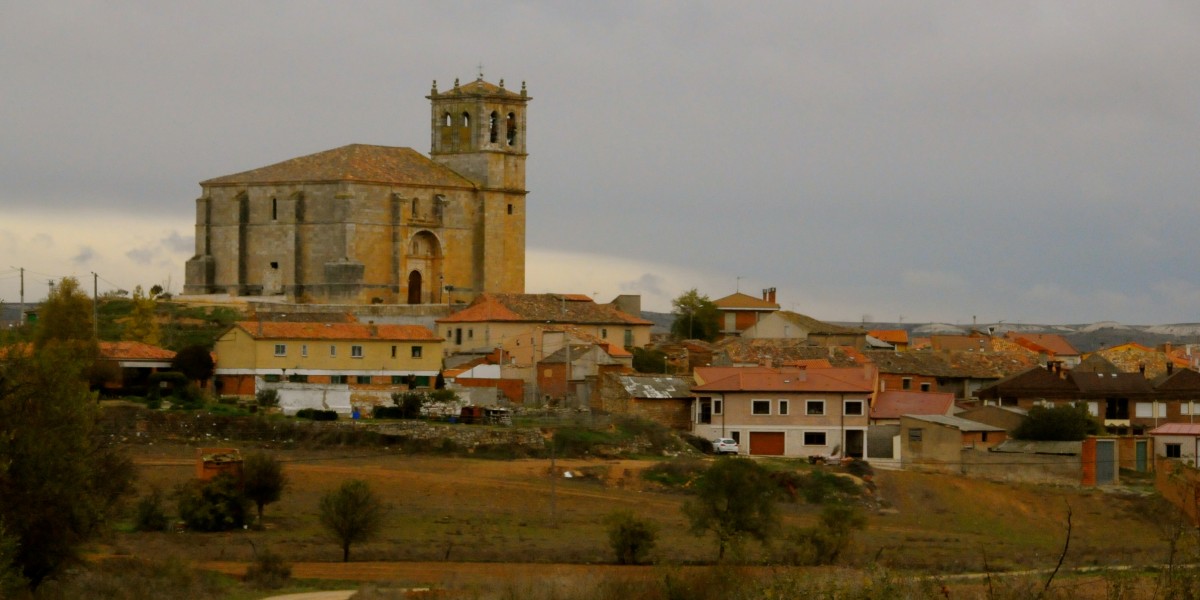
The night we arrived, it rained in the province of Burgos. The next day was cold and the roads were rather slick. It was really cold and I am from Nevada! We were to meet César today. We drove from Tortoles where we were staying to Olmedillo de Roa. Our entire trip to Spain was to come to this place. Olmedillo is a small village. If you are not paying attention you could drive right through it and miss it. It is anchored by an impressive church and there are vineyards all around it emphasizing the point that this is a good place for vines!
“We are a modest winery”, César said. There was no sign on the building that said this was a winery. It was certainly modest from the outside.
But inside, it was well organized with fermentation tanks, oak barrels stacked up and bottles docked in wire crates. César gave us a presentation of their winery. His pride in this place was very evident.I wanted to see the vineyards. Problem was that it was very cold and the rain overnight had made the roads to the vineyards quite muddy and not very driveable. We had come all the way and I was afraid that we may not be able to see the vineyard itself. Call me a romantic but I wanted to see the plants from whence the wine came! I guess the disappointment was too transparent on my face. José Luis said that we can probably make the drive. This was going to be a good day. It was a good day..just really really cold!
Where in the world is Ribera del Duero?
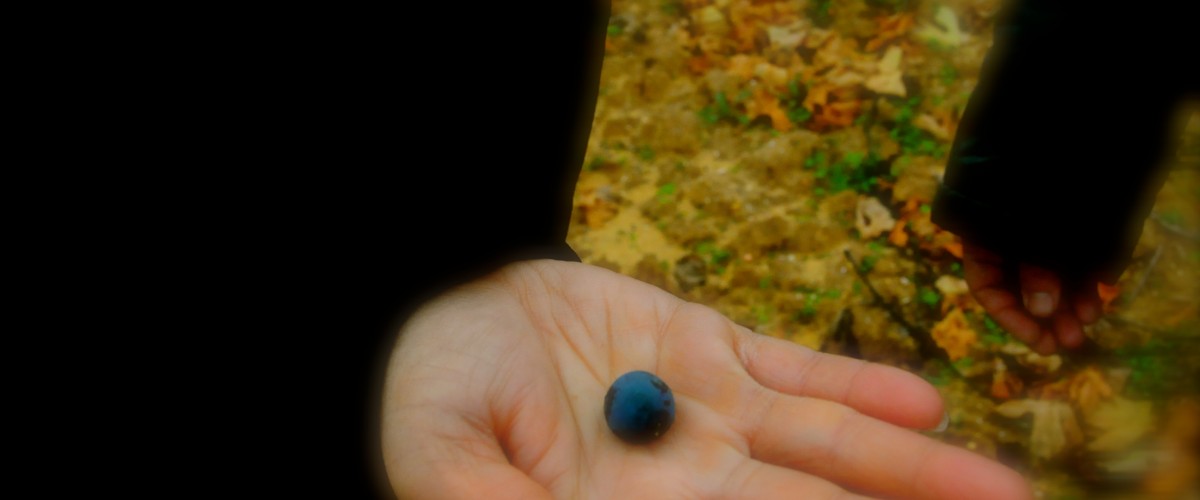
2 days. Thats how long it takes jet lag to wear off.
2hours. Thats what it took to drive from Madrid to Ribera del Duero.
If you are one who loves Spanish wines, you probably know about this place. If not, no worries. We can fix that.
If Spain is a square piece of paper (When we talk more about Spain and Spanish wines, we will keep returning to this square), Madrid is at the center of this square.
The Ribera del Duero (RdD)is a swath of land 2 hours north of Madrid, running East to West along the river Duero.
On the eastern end are the towns of Soria and Aranda de Duero and the western end is the old Spanish capital, Valladolid. Penafiel with it’s majestic castle is in the middle of this winding ribbon of land.
It is a long valley and the terrain for most part is harsh. I remarked to somebody once that “Grapes are like people. If they live an easy life, they have no personality. It’s the ones that struggle and suffer that make interesting wines.” And the vines suffer here. More on that later.
The wines of RdD varies quite a bit across this valley, all delicious but slightly different depending on which part of the valley it’s grown and the kinds of soil etc. But the common element is the grape. Tempranillo is king here!



